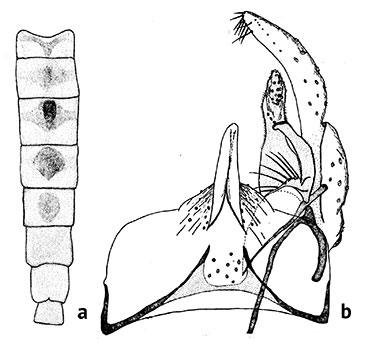Species 2d. C. frommeri Sublette & Sublette, 1971This species is a member of the staegeri group erected by Wülker et al. (1971). Adult: Ground color pale yellowish brown.thoracic markings dark brown, abdominal tergites with a dark central spot, particularly on segments 2 to 5. Frontal tubercles about 44-82 µm. Clypeus broad, clypeal setae - 48-76. Palpal proportions (segs 2 to 5) - 5 : 16 : 15 : 25. Thoracic setae - Acrostichals in a staggered row; 28-76 dorsolaterals; 8-14 prealars; 48-78 scutellars. Legs pale, some progressive darkening of tarsal segments. Fore tarsi with a sparse beard. Leg proportions:
 Male abdomen (a) and hypopygium of lectotype (b) of C. frommeri from Sublette & Sublette (1971) Superior volsella long, closest to Ei-type of Strenzke, but tending to a knob at the distal end. Inferior volsella long, extending beyond end of anal point to about halfway along the gonostylus, which is moderately swollen and narrows only very gently towards the end. Female - General coloration as male but with dark markings more extensive.
Pupa: Length 9.19-14.0 mm (Female: about 12.9-14.0 mm, Male: about 9.2-13.3 mm).  Pupal abdomen of Chironomus frommeri from Sublette & Sublette (1971) Frontal tubercles short and conical, subterminal seta about 35 µm long. About 74 - 129 recurved spines at apex of tergite of segment II; caudolateral spur of segment VIII with 7-11 spines (female), 6-12 spines (male). Swim fin with about 130 flattened taeniae. Fourth instar larva a large plumosus-type (length: female - about 18.5-22.8 mm; male - about 17.3-20 mm), ventral head length about 290 (330-430)µm. Ventral tubules long, usually anterior pair longer (Female: Ant. 2.52 mm (2.20-3.00), Post. 2.15 mm (1.68-2.48); Male: Ant. 2.31 mm (1.84-2.64), Post. 1.98 mm (1.64-2.32)). Identification: The larva of this species can be recognized by the combination of characters: large plumosus-type, dark gula and pale frontoclypeus, about 60-90 striae on ventromentum, which has a crenullated anterior margin. This does not separate it from C. crassicaudatus or C. staegeri. Cytology: 4 polytene chromosomes with the thummi arm combination AB, CD, EF, G. Molecular sequences: Found: Quebec - Trois-Rivières. The morphology and cytology have been described by Wülker et al. (1971). |
Modified: 6 October 2025
Access: Unrestricted
Copyright © 2000-2025, Jon Martin.